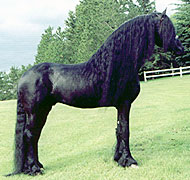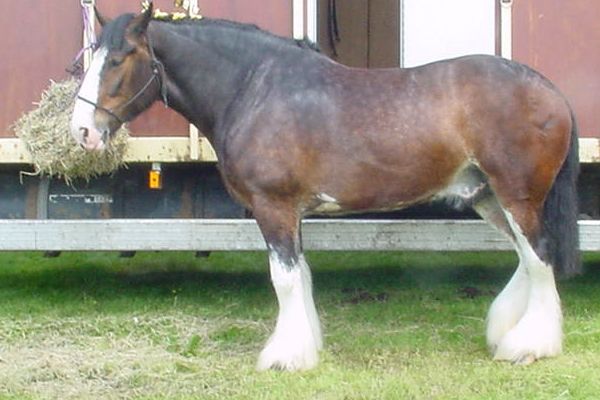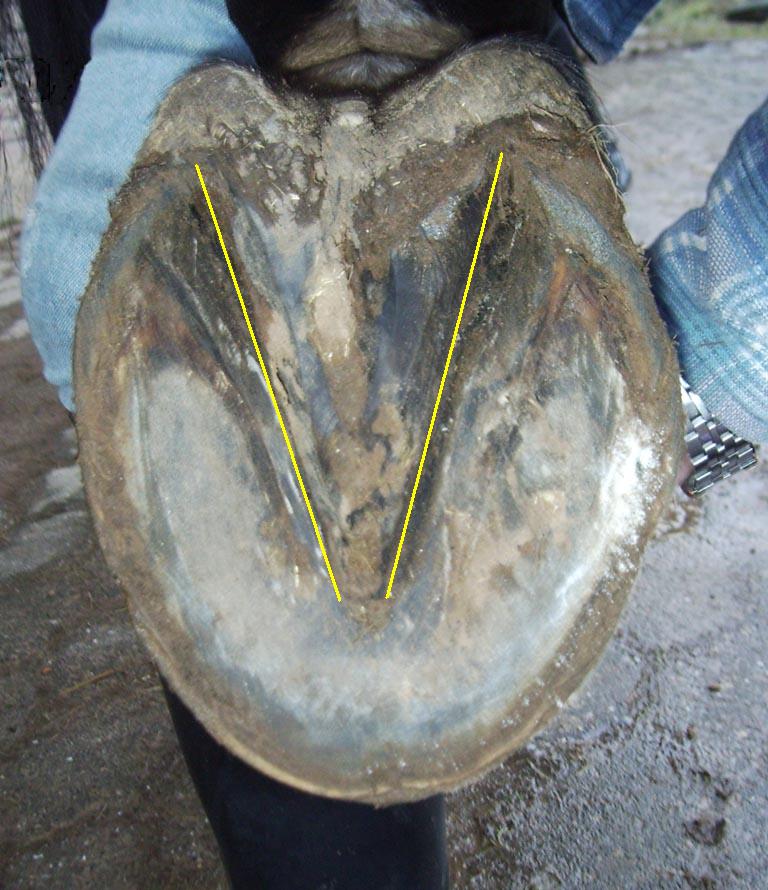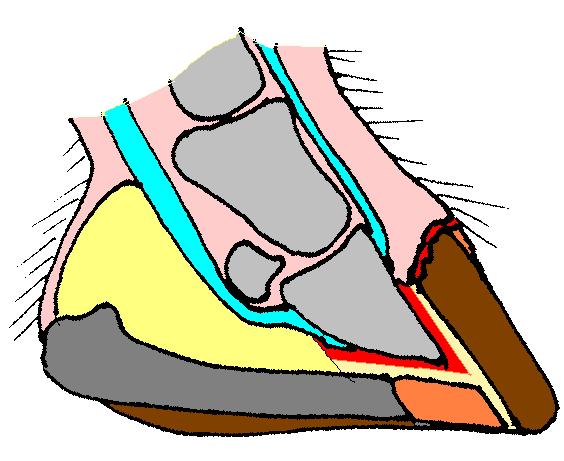|
Horse Grooming
Horse grooming is hygienic care given to a horse, or a process by which the horse's physical appearance is enhanced for horse shows or other types of competition. Reasons for grooming Grooming is an important part of horse care. Grooming a horse daily allows the handler to check on the horse's general health and well-being. At a minimum, horses are generally groomed before being worked, and are usually groomed and cleaned up after a workout as well. Horse showmanship is a horse show class that considers quality of grooming for as much as 40% of the total score. The main reasons for daily grooming include: * Improved health of the skin and coat * Decreases the chance of various health problems such as thrush, scratches, and other skin problems * Cleans the horse, so chafing does not occur under areas of tack * Gives the groom a chance to check the horse's health, such as looking for cuts, heat, swelling, lameness, a change in temperament (such as depression) which could indicate ... [...More Info...] [...Related Items...] OR: [Wikipedia] [Google] [Baidu] |
Botfly
Botflies, also known as warble flies, heel flies, and gadflies, are a family of flies known as the Oestridae. Their larvae are internal parasites of mammals, some species growing in the host's flesh and others within the gut. ''Dermatobia hominis'' is the only species of botfly known to parasitize humans routinely, though other species of flies cause myiasis in humans. General A botfly, also written bot fly, bott fly or bot-fly in various combinations, is any fly in the family Oestridae. Their life cycles vary greatly according to species, but the larvae of all species are internal parasites of mammals. Largely according to species, they also are known variously as warble flies, heel flies, and gadflies. The larvae of some species grow in the flesh of their hosts, while others grow within the hosts' alimentary tracts. The word "bot" in this sense means a maggot. A warble is a skin lump or callus such as might be caused by an ill-fitting harness, or by the presence of a warble ... [...More Info...] [...Related Items...] OR: [Wikipedia] [Google] [Baidu] |
Draft Horse
A draft horse (US), draught horse (UK) or dray horse (from the Old English ''dragan'' meaning "to draw or haul"; compare Dutch ''dragen'' and German ''tragen'' meaning "to carry" and Danish ''drage'' meaning "to draw" or "to fare"), less often called a carthorse, work horse or heavy horse, is a large horse bred to be a working animal doing hard tasks such as plowing and other farm labor. There are a number of breeds, with varying characteristics, but all share common traits of strength, patience, and a docile temperament which made them indispensable to generations of pre-industrial farmers. Draft horses and draft crossbreds are versatile breeds used today for a multitude of purposes, including farming, draft horse showing, logging, recreation, and other uses. They are also commonly used for crossbreeding, especially to light riding breeds such as the Thoroughbred, for the purpose of creating sport horses of warmblood type. While most draft horses are used for driving, they c ... [...More Info...] [...Related Items...] OR: [Wikipedia] [Google] [Baidu] |
Frog (horse)
The frog is a part of a horse hoof, located on the underside, which should touch the ground if the horse is standing on soft footing. The frog is triangular in shape, and extends midway from the heels toward the toe, covering around 25% of the bottom of the hoof. The frog is a V-shaped structure that extends forward across about two-thirds of the sole. Its thickness grows from the front to the back and, at the back, it merges with the heel periople. In its midline, it has a central groove ( sulcus) that extends up between the bulbs. The color of the frog varies between horses and can have no pigment making it cream colored, or with pigment fully or partially making it darker, and of a rubbery consistency, suggesting its role as a shock absorber and grip tool on hard, smooth ground. The frog also acts like a pump to move the blood back to the heart, a great distance from the relatively thin leg to the main organ of the circulatory system. In the stabled horse, the frog does n ... [...More Info...] [...Related Items...] OR: [Wikipedia] [Google] [Baidu] |
Sulci
Sulci or Sulki (in Greek , Steph. B., Ptol.; , Strabo; , Paus.), was one of the most considerable cities of ancient Sardinia, situated in the southwest corner of the island, on a small island, now called Isola di Sant'Antioco, which is, however, joined to the mainland by a narrow isthmus or neck of sand. South of this isthmus, between the island and the mainland, is an extensive bay, now called the Golfo di Palmas, which was known in ancient times as the ''Sulcitanus Portus'' (Ptol.). Origins The foundation of Sulci (Punic:) is expressly attributed to the Carthaginians (Paus. x. 17. § 9; Claudian, ''B. Gild.'' 518), and it seems to have become under that people one of the most considerable cities of Sardinia, and one of the chief seats of their power in the island. However, as noted by archaeologists the city was founded by Tyrians during the late 9th century bc, and most of the inhabitants were probably native Sardinians, it remained independent until Carthage conquered ... [...More Info...] [...Related Items...] OR: [Wikipedia] [Google] [Baidu] |
Stone Bruise (horse)
A horse hoof is the lower extremity of each leg of a horse, the part that makes contact with the ground and carries the weight of the animal. It is both hard and flexible. It is a complex structure surrounding the distal phalanx of the 3rd digit (digit III of the basic pentadactyl limb of vertebrates, evolved into a single weight-bearing digit in horses) of each of the four limbs, which is covered by soft tissue and keratinised (cornified) matter. Anatomy The hoof is made up of two parts. The outer part, called the hoof capsule, is composed of various cornified specialized structures. The inner, living part of the hoof, is made up of soft tissues and bone. The cornified material of the hoof capsule differ in structure and properties. Dorsally, it covers, protects, and supports P3 (also known as the coffin bone, pedal bone, or PIII). Palmarly/plantarly, it covers and protects specialised soft tissues, such as tendons, ligaments, fibro-fatty and/or fibrocartilaginous tissues, and ... [...More Info...] [...Related Items...] OR: [Wikipedia] [Google] [Baidu] |
Thrush (horse)
Thrush is a very common bacterial infection that occurs on the hoof of a horse, specifically in the region of the frog. The bacterium involved is'' Fusobacterium necrophorum'', and occurs naturally in the animal's environment—especially in wet, muddy, or unsanitary conditions, such as an unclean stall—and grows best with low oxygen. Horses with deep clefts, or narrow or contracted heels are more at risk of developing thrush. Symptoms The most obvious sign of thrush is usually the odor that occurs when picking out the feet. Additionally, the infected areas of the hoof will be black in color (even on a dark-horned hoof), and will easily break or crumble when scraped with a hoof pick. When picking the hooves around thrush areas, the differences between healthy and infected areas can be seen when white or gray tissue (healthy frog) is surrounding a dark, smelly (infected) area. Most horses do not become lame if infected with thrush. However, if left untreated, the bacteria may m ... [...More Info...] [...Related Items...] OR: [Wikipedia] [Google] [Baidu] |
Horse Hoof
A horse hoof is the lower extremity of each leg of a horse, the part that makes contact with the ground and carries the weight of the animal. It is both hard and flexible. It is a complex structure surrounding the distal phalanx of the 3rd digit (digit III of the basic pentadactyl limb of vertebrates, evolved into a single weight-bearing digit in horses) of each of the four limbs, which is covered by soft tissue and keratinised (cornified) matter. Anatomy The hoof is made up of two parts. The outer part, called the hoof capsule, is composed of various cornified specialized structures. The inner, living part of the hoof, is made up of soft tissues and bone. The cornified material of the hoof capsule differ in structure and properties. Dorsally, it covers, protects, and supports P3 (also known as the coffin bone, pedal bone, or PIII). Palmarly/plantarly, it covers and protects specialised soft tissues, such as tendons, ligaments, fibro-fatty and/or fibrocartilaginous tissues, an ... [...More Info...] [...Related Items...] OR: [Wikipedia] [Google] [Baidu] |
Hoof Bottom View
The hoof (plural: hooves) is the tip of a toe of an ungulate mammal, which is covered and strengthened with a thick and horny keratin covering. Artiodactyls are even-toed ungulates, species whose feet have an even number of digits, yet the ruminants with two digits, are the most numerous, e.g. giraffe, deer, bison, cattle, goat, and sheep. The feet of perissodactyl mammals have an odd number of toes, e.g. the horse, the rhinoceros, and the tapir. Hooves are limb structures restricted to placental mammals, which have long pregnancies; however, the marsupial ''Chaeropus'' had hooves. Description The hoof surrounds the distal end of the second phalanx, the distal phalanx, and the navicular bone. The hoof consists of the hoof wall, the bars of the hoof, the sole and frog and soft tissue shock absorption structures. The weight of the animal is normally borne by both the sole and the edge of the hoof wall. Hooves perform many functions, including supporting the weight of the animal ... [...More Info...] [...Related Items...] OR: [Wikipedia] [Google] [Baidu] |
Rump (croup)
The rump or croup, in the external morphology of an animal, is the portion of the posterior dorsum – that is, posterior to the loins and anterior to the tail. Anatomically, the rump corresponds to the sacrum. The tailhead or dock is the beginning of the tail, where the tail joins the rump. It is known also as the base or root of the tail, and corresponds to the human sacrococcygeal symphysis. In some mammals the tail may be said to consist of the tailbone (meaning the bony column, muscles, and skin) and the skirt (meaning the long hairs growing from the tailbone). In birds, similarly, the tail consists of tailbone and tailfan (tail fan). Some animals are subjected to docking, the amputation of the tailbone at or near the dock. These include dogs, cats, sheep, pigs, and horses. Humans have a remnant tail, the coccyx, and the human equivalent of docking is coccygectomy. Usage Usage varies from animal to animal. Birds and cattle are said to have a rump and tailhead ... [...More Info...] [...Related Items...] OR: [Wikipedia] [Google] [Baidu] |
Tail (horse)
The tail of the horse and other equines consists of two parts, the dock and the skirt. The dock consists of the muscles and skin covering the coccygeal vertebrae. The term "skirt" refers to the long hairs that fall below the dock. On a horse, long, thick tail hairs begin to grow at the base of the tail, and grow along the top and sides of the dock. In donkeys and other members of ''Equus asinus'', as well as some mules, the zebra and the wild Przewalski's horse, the dock has short hair at the top of the dock, with longer, coarser skirt hairs beginning to grow only toward the bottom of the dock. Hair does not grow at all on the underside of the dock. The tail is used by the horse and other equidae to keep away biting insects, and the position and movement of the tail may provide clues to the animal's physical or emotional state. Tail carriage may also be a breed trait. Tails of horses are often groomed in a number of ways to make them more stylish for show or practical for w ... [...More Info...] [...Related Items...] OR: [Wikipedia] [Google] [Baidu] |




.jpg)

